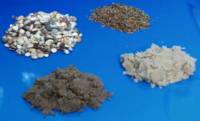|
The substrate material used in a tank may be purely decorative, or it may serve a particular
purpose - such as forming part of the filtration (as in UGF) or as a rooting medium for
growing plants. The two most commonly used substrate materials are gravel and sand.
|
|
Gravel is available in a range of sizes from 'pea' gravel to fine (2-3mm) size. It is also
available in many colours and textures in addition to the 'natural' gravel. Pea-sized gravel
is probably the most commonly employed; larger sizes can allow debris to fall between the stones
where it will decay and affect water quality. For planted tanks, it is often advantageous to use
a finer grade of gravel, which should be the lime-free type. Note that many gravels sold for
aquarium use are not lime-free unless they specifically say so.
|
 |
|
Coral gravel can be used to help maintain hardness and pH in hard-water setups. However, it is
often sharp-edged and may damage the bodies of fish which like to dig (such as cichlids) -
it is therefore better to place the gravel in a filter or use coral sand instead.
|
|
Sand is also available in different grades and colours. Fine lime-free silica sand
('silver sand') is usually available from DIY stores and garden centers. It will often be
graded and prewashed, although an additional rinse is advisable for aquarium use. Fine grade sands
intended specifically for aquarium use are also available, which may be cleaner and require little or no pre-washing.
Sand is particularly useful for tanks containing bottom feeders with delicate barbels - Corydoras
catfish, for example, seem to enjoy rooting around in the sandy substrate for food.
It is generally easy to keep clean as debris remains on top of the sand.
Sand should not be used with an undergravel filtration system as it compacts down too hard.
|
|
Some manufacturers produce special substrates for use in planted tanks. Some
are designed to be mixed with gravel or sand, whilst others can be used alone. They are usually
clay-based and rich in iron and other nutrients and trace elements required by plants.
|
|
Despite the improved aesthetics provided by a gravel or sand substrate, there are
some situations where it may be preferable to omit the substrate altogether. These include tanks
for fry-rearing and isolation/quarantine tanks, where the tank needs to be easy to clean thoroughly.
|



